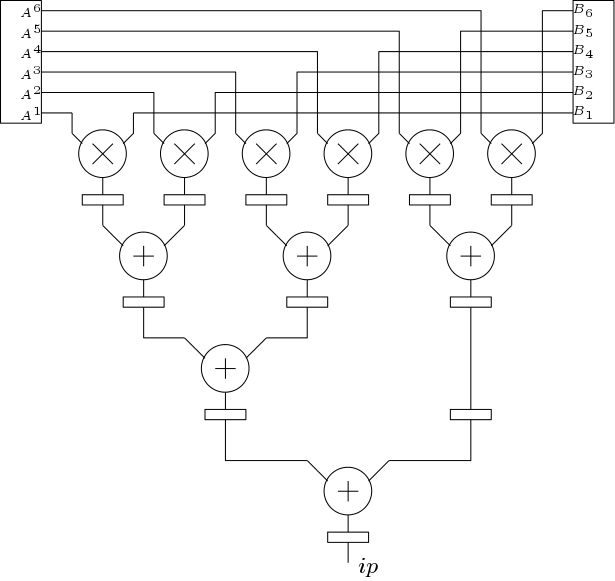Apart from scalar-vector multiplication, Vector-Vector multiplication is another very important arithmetic operation in implementing signal or image processing algorithms. The matrix multiplications can also be achieved through vector-vector multiplication which is also called as inner product computation.
In this tutorial, we will discuss multiplication of matrix A (6X6) with matrix B (6X6) using Vector-Vector multiplication. The multiplication result is matrix C (6X6). The Vector-Vector multiplier is shown in Figure 1. Here, matrix A is shown in a memory bank and B matrix is also stored in another memory bank. These memory banks can be configured as ROM or RAM. The memory banks has six outputs and each output is a word. Here, ![]() denotes
denotes ![]() row of matrix A and
row of matrix A and ![]() denotes the
denotes the ![]() column of matrix B.
column of matrix B.
The first stage of the Vector-vector multiplier is multiplier stage and the second stage is adder tree. If there are n elements in the vector, then there will be n multipliers used and (n-1) adders will be needed in the adder tree. The pipeline registers are inserted between adders or between a multiplier and an adder.

Timing Complexity: The total timing complexity to multiply two 6×6 matrices is expressed as
![]()
Here, ![]() is the latency period of the Vector-vector multiplier and it is equal to four clock cycles. The second term is for multiplying two nxn matrices. Thus total time taken to multiply two 6X6 matrices is (4 + 36=40) clock cycles. After the latency period, we get one inner product per cycle. Then these outputs can be written to any other memory blocks.
is the latency period of the Vector-vector multiplier and it is equal to four clock cycles. The second term is for multiplying two nxn matrices. Thus total time taken to multiply two 6X6 matrices is (4 + 36=40) clock cycles. After the latency period, we get one inner product per cycle. Then these outputs can be written to any other memory blocks.
